10 Interesting Facs About Andalusia: Things You Need to Know Before You Go

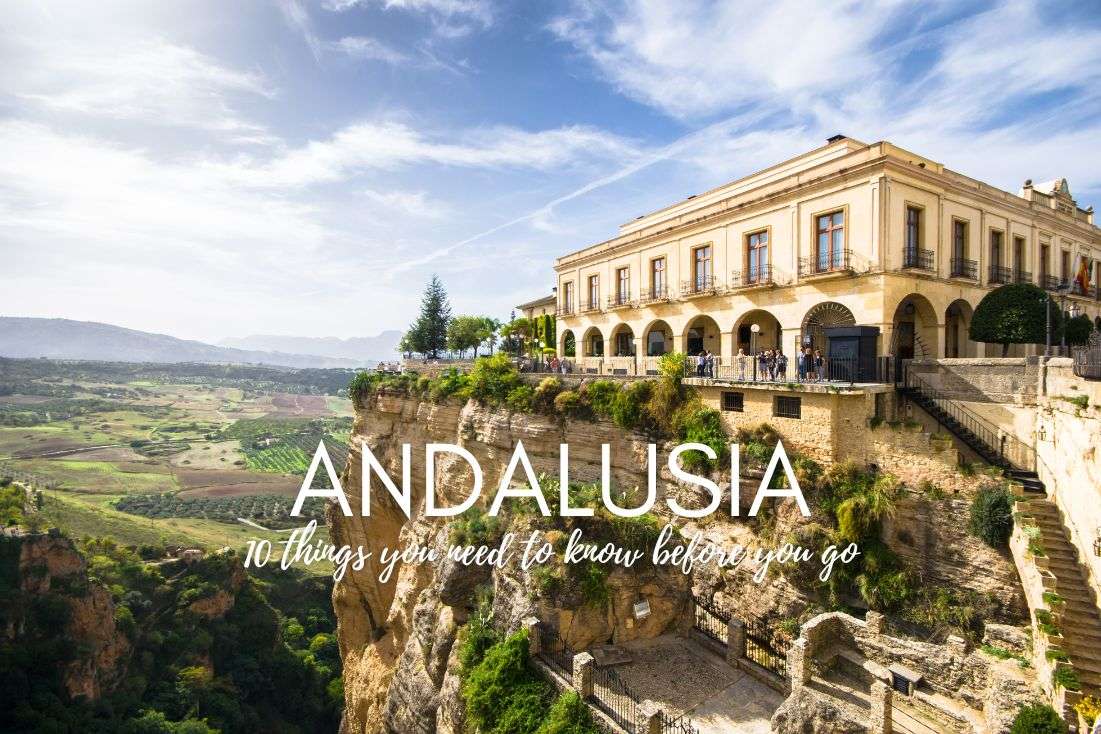
You don’t want to visit a culturally distinct destination like Andalusia not knowing what it’s all about! As you may or may not know, Spain is not a homogenous lump of a country. Its regions are fiercely independent and diverse and what is true for the north often isn’t for the south and vice versa. For more about Spain in general, we’ve put together a nice background post for you.
You might also be interested in reading:
- Andalusia Itinerary: Southern Spain in 10 Days
- Barcelona Itinerary: 5 days in Gaudí’s Metropole (with day trips)
- All You Need to Know about Spanish Tapas (+Restaurant Tips)
- The 10 Best Museums in Spain’s Top Cities
- The 16 Most Beautiful Beaches in Spain
1. The Basics
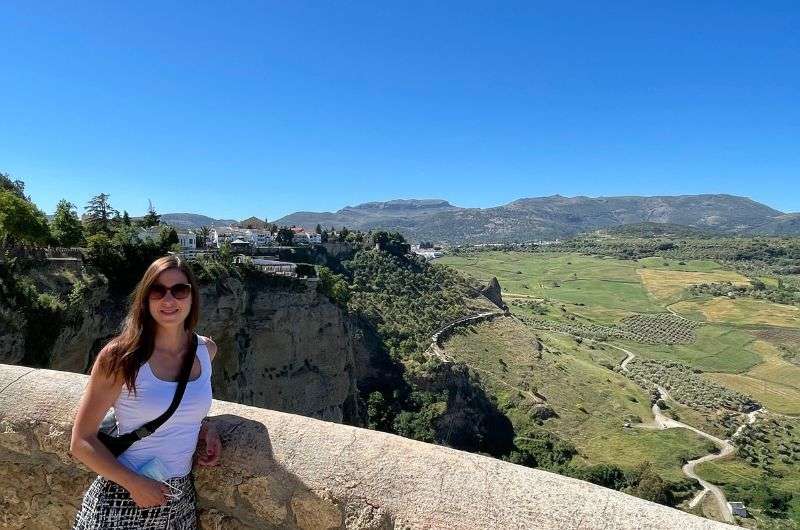
The air is fine today... expect lots of bugs! Views from Ronda
Andalusia is a region that could be considered the poorer part of Spain, where agriculture used to be the main source of income, and for many people, it still it. Just think that one third of the world’s olives come from Andalusia. That’s a lot of olive trees! It also means a lot of bugs. You can measure the cleanliness of the air by how many dead bugs there are on your car’s windshield—the more the better!
It’s also way down south, which means it’s hot as heck in the summer and the landscape is mostly flat and dry. Aside from the olive groves that is. You won’t see many trees and it feels like you’re in the desert half the time. Even the mountains (or rather hills) are bare. Which is actually kind of nice, because you get great views from them. Check out the hills around Nerja, we’ve included a cool hike in this post. See below for more on the weather in Andalusia.
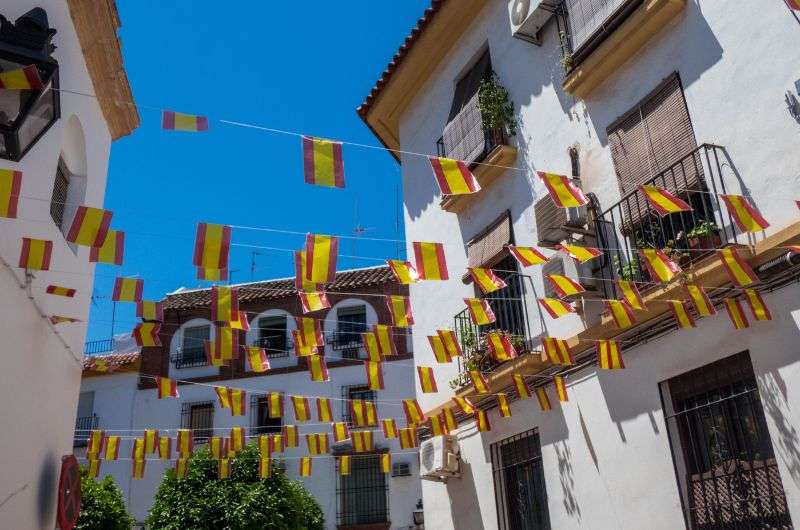
The charming streets of Cordoba
On the other hand, the roads are terrific, and driving is a delight. The highways that seem to lead even into the smallest towns are wide, good quality and free. Plus, there is never too much traffic.
Definitely rent a car to get around. Buses are unreliable and who wants to travel by bus anyway. Trains exist but they are expensive and don’t take you to all those special places that aren’t smack in the middle of a big city. A rental car is the way to go for ultimate freedom. Just make sure it’s a small one or you won’t be able to park it anywhere.
Tip: Book one of the best rated hotels in Andalusia.
One thing that stands out in Andalusia and that is a huge reason for visiting the region is the Moorish architecture. There are palaces in all bigger towns, with amazing courtyards, gardens and tiles galore. The tiles! So many tiles! Sevilla’s Alcazar is hard to beat, though Granada’s is probably the most famous. The leftovers of Islamic reign are very apparent all over the place, like in the mosque-turned-churches of Cordoba and Sevilla.
2. History of Andalusia
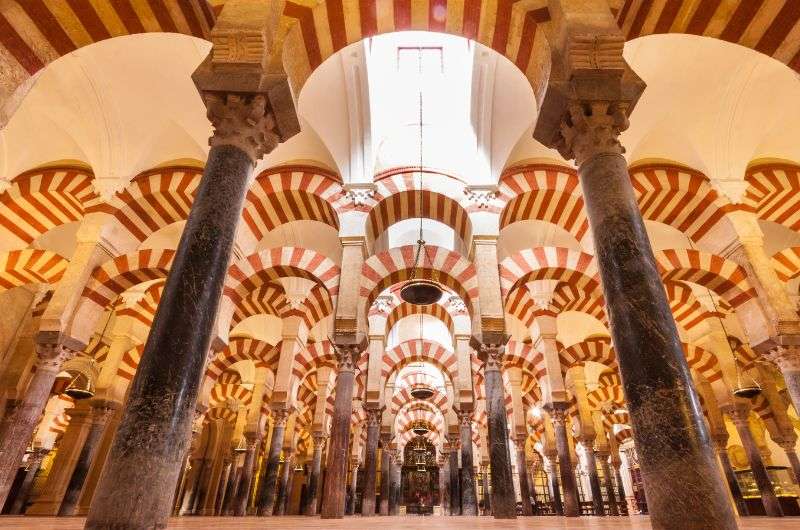
The mosque part of the Mosque Cathedral in Cordoba
When I think of Andalusia, I picture Moorish architecture, Catholic celebrations, sunshine and tapas. For some of you, it might also mean flamenco and bullfighting.
Sincere curiosity: If you are not Spanish and are excited about bull fighting, what is wrong with you?
Who were the Moors? Ah, yes, those guys with the buildings with millions of colorful tiles and fancy courtyards and intricate design. The opposite of minimalism. The Moors didn’t call themselves Moors, it was the Christian Europeans that used the term for Berbers of northwest Africa, Arabs in general and then Muslim Europeans as well.
It won’t come as a shock then that it has been used as a derogatory term for black Muslims especially, so I wouldn’t throw the word around carelessly if you want to be politically correct or aren’t fond of being an a-hole in the eyes of a whole people. It is an archaic term though so don’t worry about it too much.
Andalusia’s history goes way further back though, with Neanderthals living on Gibraltar rock. Iberians didn’t just pop up out of nowhere but came in from northern Africa. Then, Phoenicians founded various trading posts and the sea port of Cadiz (called Gadiz back then) in 1100 BCE, making it Europe’s oldest city. During the 5th century BCE, the Carthaginians and Greeks colonized the coastal part of Andalusia, and the indigenous tribes hung out in the interior.

We forgot our clothes, but we are here to conquer Spain!
Enter the Romans, who conquered Andalusia between 210 and 206 BCE and stayed around to elevate the region for about 700 years. The Romans defeated the Iberians on a site near Sevilla called Italica and it was the first Roman city in Spain. Its ruins can be visited today.
The Romans left a sizeable legacy, including architecture (like aqueducts and amphitheaters), civil rights adopted from Rome and perhaps the most important of all, Latin. The Spanish language (as well as Italian, French, Portuguese, Romanian and others) is derived from Latin. Rome, on the other hand, imported Spain’s olive oil and wine, so I’d say a win-win!
The Visigoths and Vandals pushed out the Romans in the 5th century CE, ran the place in complete chaos, couldn’t stop fighting to save their lives, and were promptly overrun by warriors from Arabia and northern Africa in 711 CE.
The Moorish era had commenced and left behind all those pretty palaces we all flock to see now. The mosque in Cordoba and palaces in Granada and Seville are some of the most fantastic Moorish buildings you can see in all of Spain. Besides palaces with over-the-top decorations, economic growth and cultural prosperity was also something attributed to Moors.

Christopher Columbus’ tomb in the Cathedral in Sevilla
When the Muslims arrived to Spain, they pushed the Christians up north. The Christians weren’t having it and the border between the two kept moving up and down depending on who was having a better day, but with the south being where most Moors hung out, the largest concentration of Moorish architecture can be found in Andalusia. The palace in Granada was the last Moorish stronghold and it was taken by Catholic monarchs Isabel and Ferdinand in 1492.
That was the same year that these two sent Christopher Columbus (see his tomb in Seville) out to find a new way to Asia (oops). It was more Isabel’s doing, she was on a massively successful power trip while Ferdinand was sleeping around not doing much of anything.
After the Moors were expelled, Christianity spread like wildfire since any other religion was banned and anyone with a different opinion was tortured into either being a Christian “voluntarily” or dying a painful death.
3. People of Andalusia
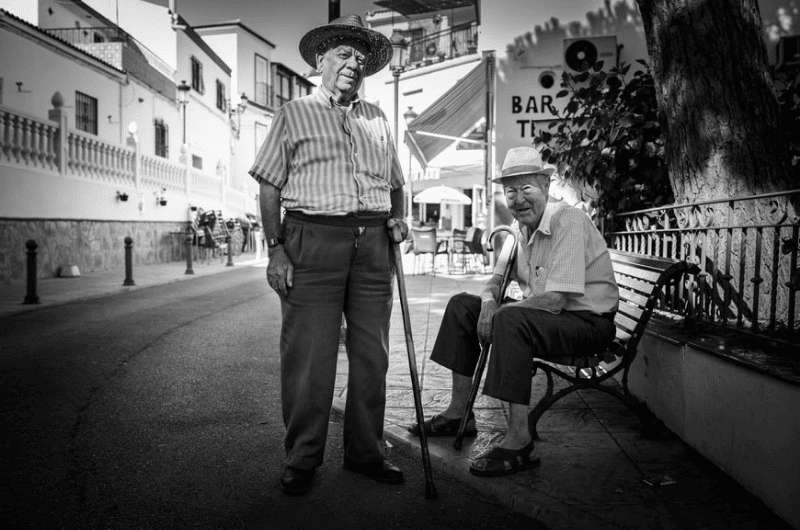
Community is a strong value in Andalusia
The people of Andalusia are overwhelmingly warm and try to make any visitor feel welcome. You will be a part of the family faster than you feel comfortable!
If you typically need a large bubble of personal space around you, you will get it popped within minutes of arriving in Andalusia. Just go with the flow and hug your new besties! I dare you not to get touched, patted, and squeezed.
Another often unwelcome side-effect of the Spanish temperament mixed with extroversion, is ubiquitous catcalling. Be prepared to be wistled at, yelled at and commented towards on a regular basis. It doesn’t always have to be sexual, and it might even come from that cute grandpa over there, but if you aren’t used to it, it can catch you off guard and make you feel uncomfortable.
Our top tips for Andalusia:
- The only way to get around: Always rent a car
- Visit in the spring of fall: It gets too hot in the summer
- Eat tapas: They are even free in Granada!
- Don’t forget about Gibraltar: Our favorite place!
With community and family being at the top of the list of Andalusians’ values, you will see this shine through in every aspect of life. Children and the elderly are just as important as everyone else and are not looked down upon or separated from their families as much as in other societies. Kids at a bar at 11 pm? No problem! Grandma and gramps tagging along for tapas with friends? Why not?
Every generation in Andalusia is equally cheerful and sociable. You won’t ever be bored and might get your ear chatted off during that quick dinner that turned into a 4-hour conversation. Actually, there’s no such thing as a quick dinner in Andalusia. If you are invited to dinner, make plans to stay all night, otherwise you will be questioned and might be considered rude.
Everything seems like fun and games with the Andalusian people. I felt everyone is on vacation all the time. There is absolutely no sense of urgency with these guys! Deadlines, timetables, opening times, appointments, treat it all with the same dose of leisure the Andalusians do. If you don’t, you will sprain your brain trying to figure out how these people ever get anything done. If you set up a time for something, they accept it as a suggestion. But why do it now if you can do it tomorrow? Or next month.
4. Weather in Andalusia
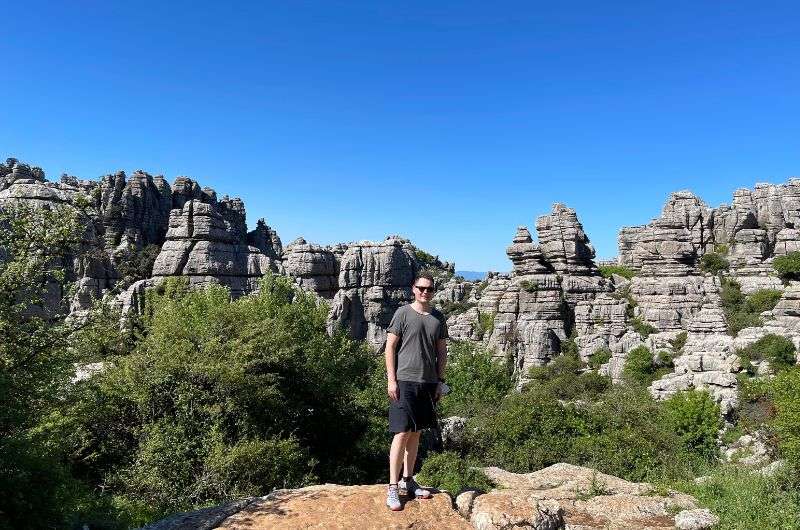
Bearing the sun in El Torcal
Visiting the part of Spain closest to the equator in the summer is not the best idea. Temperatures soar past 100ºF (37ºC) in July and August. Just ask Sevilla, who became the first major city in the world to start naming and categorizing its heat waves.
In Andalusia, you can expect a warm, Mediterranean climate. What does that mean? In short, the winters are mild and the summers are not mild. In 2021, temperatures in January were around 60ºF (15ºC). In March, it doesn’t get colder than 70ºF (21ºC). When we visited in May? We had to retreat to the car on several occasions for an AC break! It was 90ºF (33ºC) and it did not feel like spring! In October, you’ll still get temps up in the 80s.
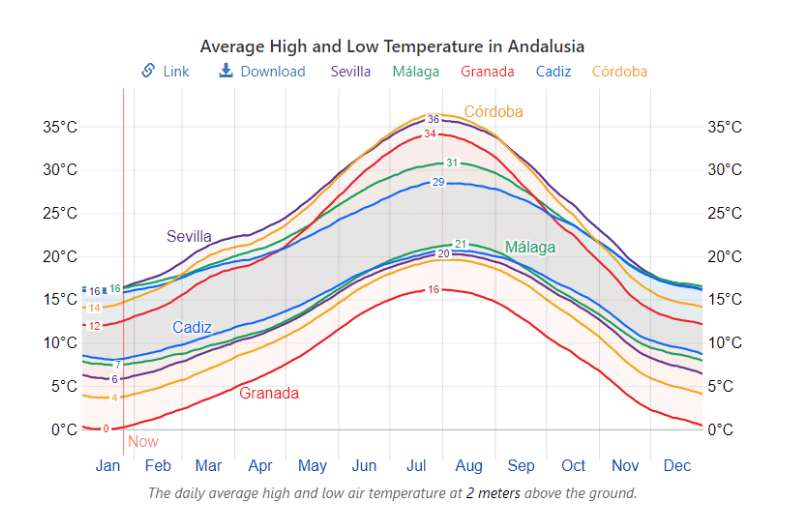
Look at those temps! And these are averages, so they do get higher. You have been warned. Image source: https://weatherspark.com
There are on average 300 sunny days per year in Andalusia, so bring your sun hats and glasses! And a personal AC unit if you have one. It doesn’t rain much, mostly in the late fall through to early spring. In the summer, everyone is praying for some rain, but it rarely does.
Make sure you stay at a hotel with air conditioning or you will regret it!
5. Tapas and restaurants in Andalusia
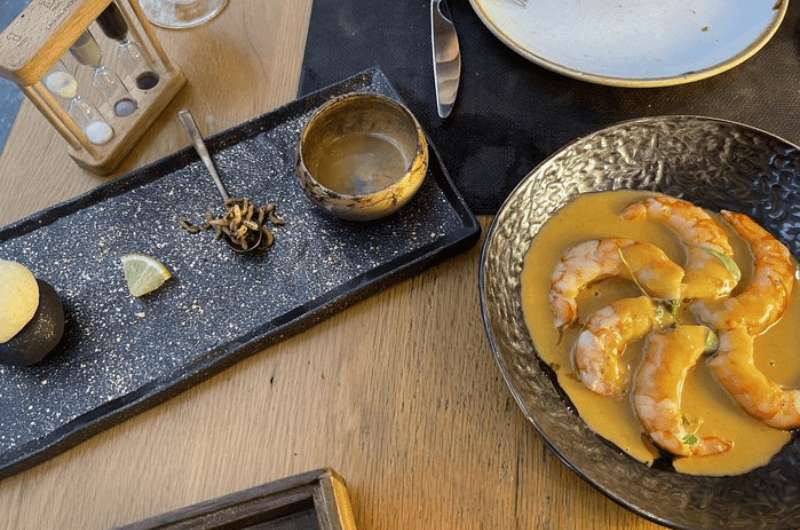
Excuse me, you want me to do what with those? (Notice the spoon!)
The restaurants in Andalusia are charmingly rustic. There are sophisticated places as well, mostly in cities like Malaga, which is a foodie heaven.
Tip: I had the best steak in the history of steaks in Malaga at a restaurant called Matiz.
In other cities, you might need to do some digging if you want some style. That’s not to reflect on the quality of the food, which is mostly great. There just isn’t much emphasis on design. If you’re ever overwhelmed and just want good food, my go-to is the Hard Rock Café chain. The Hard Rock in Seville was perfect.
Hanging out in restaurants, talking for hours, especially after a late dinner, is the thing to do in all of Spain. So join in on the fun and be sociable! Also, if you see people sitting at the bar throwing trash onto the floor (napkins, pistachio shells, etc.) just act like it’s no big deal. It’s the Spanish way.
We can’t talk about food in Andalusia and not talk about tapas. This typically Spanish food, or should I say eating style, is famous around the world. Tapas are tiny portions of food, sometimes as small as a bowl of olives, but can be a miniature paella just as well.
Tapas are meant for sharing amongst everyone at the table and encourage interaction. In some places in Andalusia, like Granada, you get tapas for free every time you order a drink. The more drinks you order, the better the tapas you get! That’s also the reason why alcoholic drinks are on the expensive side.
Tip: I have very fond memories of the tapas at Anyway Wine Bar in Malaga. And at Jury’s Café and Wine Bar in Gibraltar, you can have tapas and fish and chips at once, which totally won us over. We loved it there too.
Always remember siesta time, which is a resting time during the middle of the day where most establishments and shops close. For restaurants, siesta is mostly between 4 pm and 8 pm. No eating dinner until late!
Tip: These are the best hotels with their own restaurants on site.
6. Andalusia Geography

At the end of Spain on the Rock of Gibraltar
Sitting at the very south of Spain, Andalusia is bordered in the north by the Sierra Morena Mountains. The Guadiana River separates Andalusia from Portugal on the west, and the coast finishes the work of carving out the region in the south and east.
Andalusia also claims the southernmost point in mainland Europe – Punta de Tarifa. You can see Africa from Spain, ok, it’s that far south. At one point, it’s only 8.0 miles or 14.4 km across the Strait of Gibraltar to Morrocco.
Note: For all intents and purposes, we treat Gibraltar as part of Andalusia on this blog. It is indeed not part of Spain, being a British Overseas Territory, but it will be included in other blog posts about top places to go in Andalucia, best tapas restaurants, etc. Because we went there as part of our Andalusia trip and loved it so much! It even has its own post.
Though if you want to be precise, you can pretty much hop into Morocco from Melilla or Ceuta, so that would be where Spain is closest to Africa. These are Spain’s two semi-enclaves on the African coast. Not sure if there is an actual line there, but you could potentially stand with one leg in Africa and one in Spain. The barbed wire would probably make that a little uncomfortable though.
Andalusia is hard to beat in terms of terrain. It is the only region (and country!) that has an Atlantic and Mediterranean coast, making it a major maritime hub, but also dotting it with many fine beaches that go along with that. The ones that line the Mediterranean Sea will have warmer, calmer waters, while those by the Atlantic are colder, wilder, and I say more spectacular.
Mountains cover over 50% of Andalusia. Don’t expect the Alps, most mountains in Spain feel like hills. Still, the highest peaks of Mulhacén and Veleta are over 3,400 m (11,000 feet) high.
Vast parts of Andalucia are very dry and flat, with vast plains of low vegetation and olive groves. The further north you go in Andalusia, the greener the landscape becomes.
7. Andalusia Politics
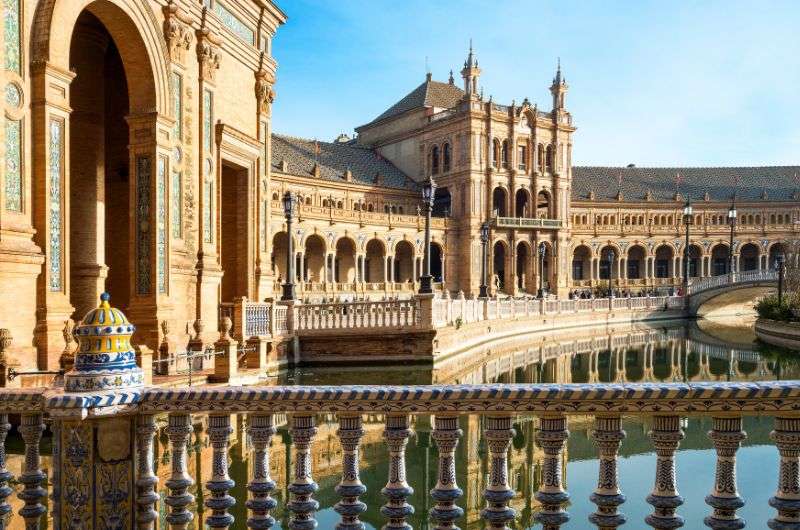
The government offices in Sevilla
Andalusia is one of 17 autonomous regions in Spain. As such, it has its own president, Parliament and Government Council. These guys can make their own laws, catch their own bad guys, and can have separate COVID restrictions. To a degree though, they operate within the bounds of the national government of Spain.
Nerd moment: The fact that the entire country of Spain is divided into autonomous regions is a rare occurrence in the world. Typically, autonomous regions are geographically or otherwise distinctly separate from the rest of the country. But not the whole thing! Examples are Quebec (in Canada), Macau (China) or Puerto Rico (USA). Russia has a ton of them but who can honestly say they know what the duck is going on there. So Spain is basically the United States of Spain, but not officially.
The capital of Andalusia is Sevilla, where the Parliament sits in a former hospital and the President is in a former university building. Upcycling at its best.
8. Religion and Traditions in Andalusia

Santa Semana celebrations. Not spooky at all
Christianity is still strong in Andalusia, being more visible than in other parts of the country but not in your face. Even though Spain doesn’t have an official religion and religious freedom is guaranteed by law, families in the south take Sunday church day as a chance to really dress up and show off their love of Christ.
Where you will certainly be able to tell that the majority of people are Catholic are holidays. The most celebrated holidays are holy days, with Santa Semana preceding Easter being the most important event celebrated in all of Andalusia (and all of Spain). There are parades with floats and costumes that look like KKK members (we’ve explained this more in the background article to Spain).
In Granada, Corpus Christi is another big week-long celebration. There is a parade with a lady on a dragon and a whole bunch of characters with huge heads representing various historical figures. Then on a different day there is a separate procession that is religious and people actually cry. And then laugh and then cry. Spaniards, eh?
Overall, there are over 3000 fiestas in Andalusia every year, so there is always a party happening somewhere! There are even mock battles between Moors and Christians. I have yet to see one but I can tell you right now that the mock win over the Moors has to be spectacular and probably very biased.
Another popular way to celebrate are pilgrimages – basically walking from point A to point B in honor of a local saint, virgin or whatever Christian figure is revered in the area. The El Rocio Pilgrimage is something out of a western movie. People dress up in traditional garb and make their way on horseback or in a cowboy-looking covered wagon. It’s hilarious.
If there is one fair to rule them all, it has to be the one in Sevilla. It is short, only 6 days. They bring out all the stops, it’s a non-stop party that exceeds anyone’s expectations. Except for the bulls in the „season’s best bull fights“. They all end up very dead.
9. Bullfighting in Andalusia
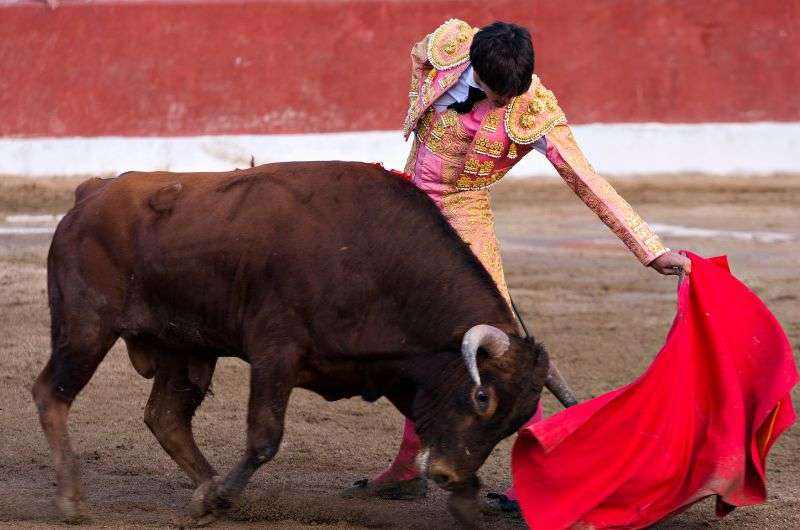
That was a close one!
Since bullfighting has still held on to some leftovers of glory in Andalusia, one of the large traditional festivals in the Feria de Pedro Romero in Ronda. Pedro Romero was a famous bullfighter that apparently fought thousands of bulls without even a scratch (Pedro is the one with no scratches, the bulls weren’t so lucky and ended up with a million holes behind their neck). He also brought bullfighting into the limelight by being respectable, whatever that means. I guess in contrast to the rednecks that were bullfighters before him? This celebration is—you guessed it—a week long and comes with all the glory and glitz of bullfighting with costumes from a time when it still had glory and glitz.
This tradition is still alive and kicking in Andalusia, more so than in the rest of the country (aside from Madrid where they are also excited by it). So you have a chance to see it with your own eyes, aren’t you lucky?!
The more forward-thinking peeps in Catalonia tried to outlaw the glamorized animal murder passing a law banning it in 2010. The national government overturned the ban, but Catalonia basically showed them the middle finger and hasn’t had a bull fight since their original ban. Be like Catalonia.
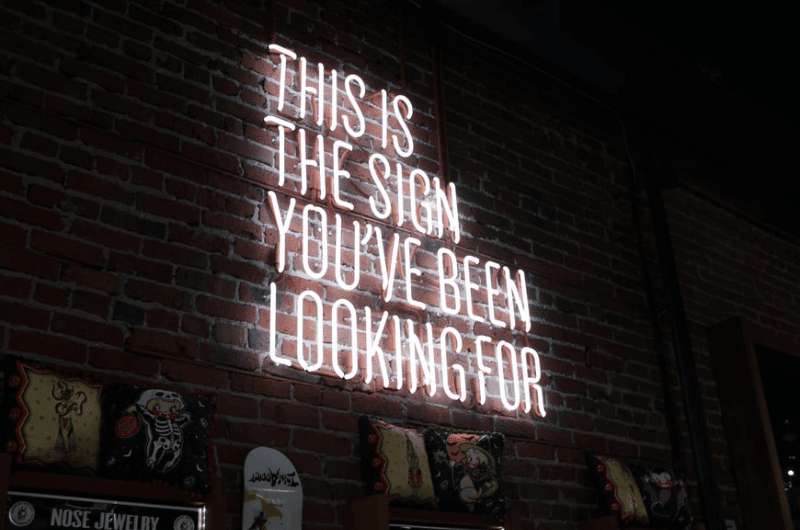
If you’re undecided if you should see a bull fight, don‘t.
Some bull arenas do informative tours that at least attempt to explain the history behind bull fighting and try to make you think it’s a wonderful tradition. The one in Granada was good. They still fight bulls there too.
The tiny, picturesque town of Ronda, sitting high above a river gorge, has one of the oldest bull rings in Spain. Another good spot to see a dude poking spears into a bull is Seville.
10. Flamenco in Andalusia
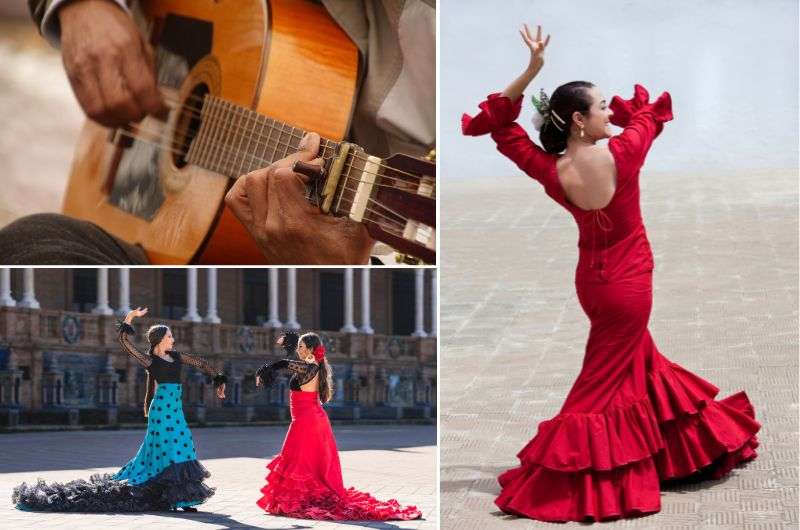
You’ll sometimes even spot a flamenco performance in the streets
If watching someone slowly torture a bull to death isn’t what you consider a well spent afternoon, maybe flamenco will float your boat. My boat sank, but your experience may vary. A traditional folk dance... is it a dance really? It’s more of a performance. A telenovela with guitar music! There is drama, there are emotional face expressions, clapping and stomping feet and sweat flying around.
If that sounds appealing, don’t book anything online. If you really want to do this, do it right. Head over to the small rooms or caves (cuevas) around Andalusian towns, notably Sevilla or Granada. Look out for flyers by the entrances with show times or ask around in local bars. The best shows will be those that don’t go out looking for tourists to join.
Are you excited to visit Andalusia? We’ve done the research in person and put together a list of the best spots to see based on our experience. Or, browse through our other posts about Spain and extend your trip to the whole country! Don’t forget to include an island getaway in Mallorca or perhaps stay on Tenerife!
This post may contain affiliate links. We earn a small commission if you make bookings through our links, at no additional cost to you. This helps us keep this blog running, thank you!


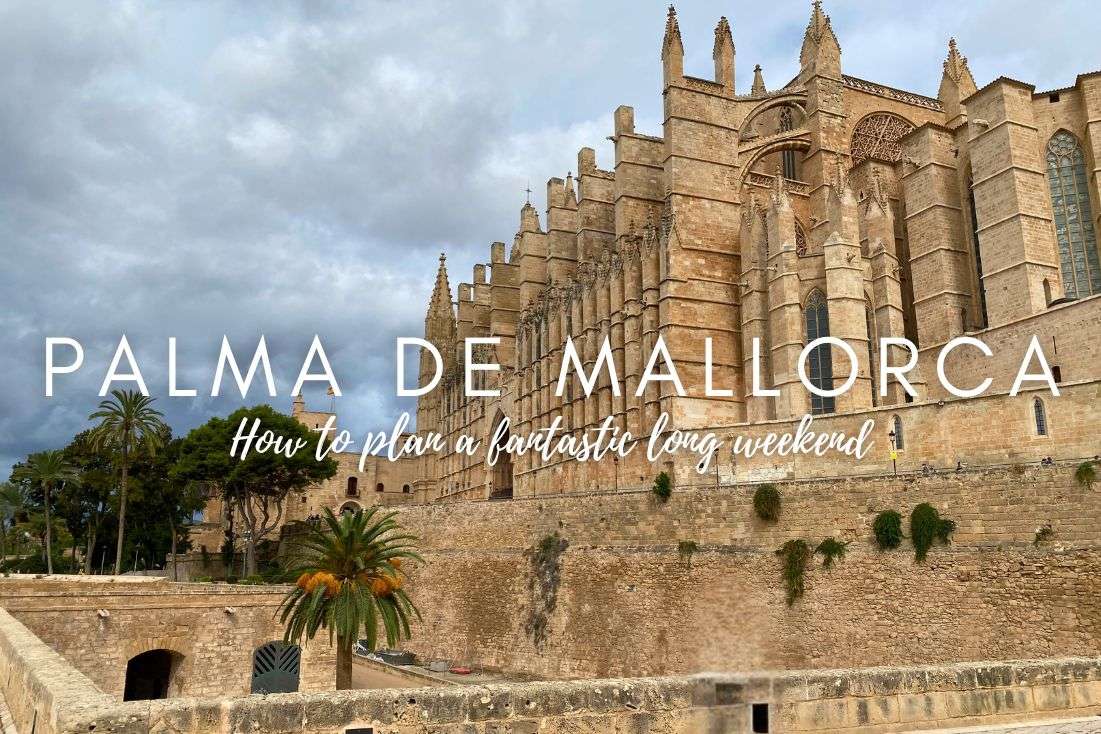
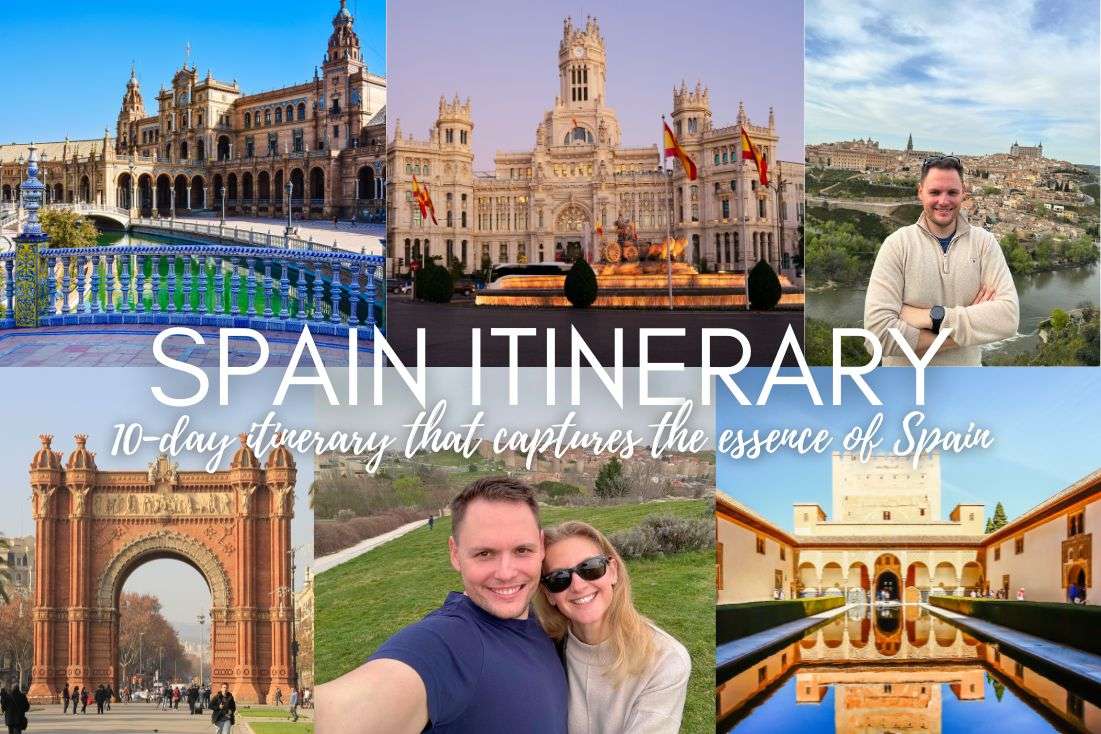
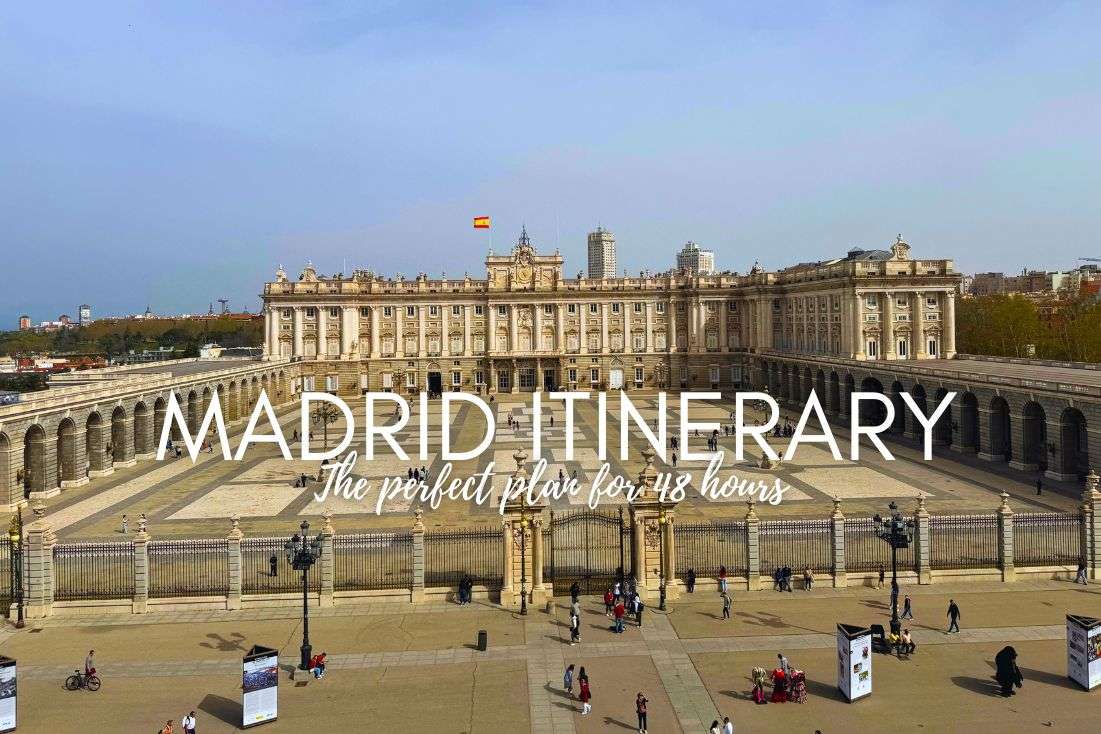





Comments | Thoughts? Give us a shout!